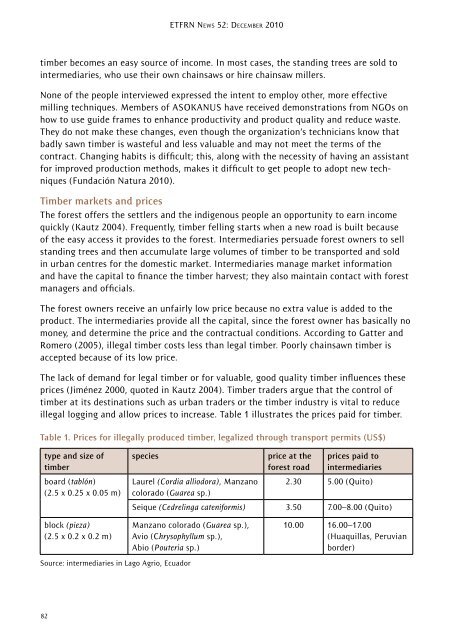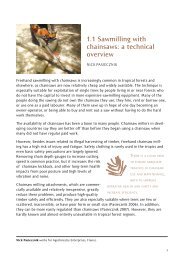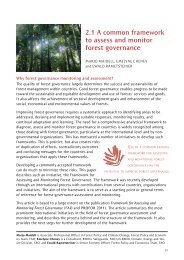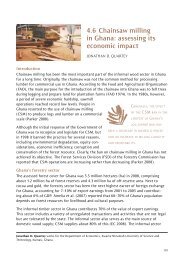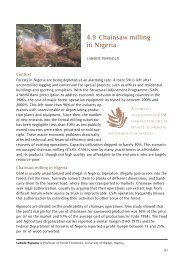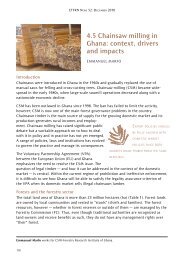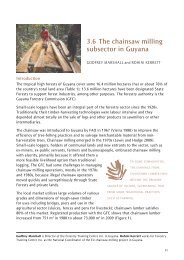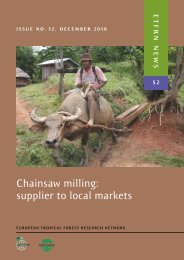Chainsaw milling: supplier to local markets - European Tropical ...
Chainsaw milling: supplier to local markets - European Tropical ...
Chainsaw milling: supplier to local markets - European Tropical ...
Create successful ePaper yourself
Turn your PDF publications into a flip-book with our unique Google optimized e-Paper software.
82<br />
ETFRN NEws 52: DEcEmbER 2010<br />
timber becomes an easy source of income. in most cases, the standing trees are sold <strong>to</strong><br />
intermediaries, who use their own chainsaws or hire chainsaw millers.<br />
none of the people interviewed expressed the intent <strong>to</strong> employ other, more effective<br />
<strong>milling</strong> techniques. members of asokanus have received demonstrations from nGos on<br />
how <strong>to</strong> use guide frames <strong>to</strong> enhance productivity and product quality and reduce waste.<br />
They do not make these changes, even though the organization’s technicians know that<br />
badly sawn timber is wasteful and less valuable and may not meet the terms of the<br />
contract. Changing habits is difficult; this, along with the necessity of having an assistant<br />
for improved production methods, makes it difficult <strong>to</strong> get people <strong>to</strong> adopt new techniques<br />
(Fundación natura 2010).<br />
Timber <strong>markets</strong> and prices<br />
The forest offers the settlers and the indigenous people an opportunity <strong>to</strong> earn income<br />
quickly (kautz 2004). Frequently, timber felling starts when a new road is built because<br />
of the easy access it provides <strong>to</strong> the forest. intermediaries persuade forest owners <strong>to</strong> sell<br />
standing trees and then accumulate large volumes of timber <strong>to</strong> be transported and sold<br />
in urban centres for the domestic market. intermediaries manage market information<br />
and have the capital <strong>to</strong> finance the timber harvest; they also maintain contact with forest<br />
managers and officials.<br />
The forest owners receive an unfairly low price because no extra value is added <strong>to</strong> the<br />
product. The intermediaries provide all the capital, since the forest owner has basically no<br />
money, and determine the price and the contractual conditions. according <strong>to</strong> Gatter and<br />
romero (2005), illegal timber costs less than legal timber. poorly chainsawn timber is<br />
accepted because of its low price.<br />
The lack of demand for legal timber or for valuable, good quality timber influences these<br />
prices (Jiménez 2000, quoted in kautz 2004). Timber traders argue that the control of<br />
timber at its destinations such as urban traders or the timber industry is vital <strong>to</strong> reduce<br />
illegal logging and allow prices <strong>to</strong> increase. Table 1 illustrates the prices paid for timber.<br />
Table 1. prices for illegally produced timber, legalized through transport permits (us$)<br />
type and size of<br />
timber<br />
board (tablón)<br />
(2.5 x 0.25 x 0.05 m)<br />
block (pieza)<br />
(2.5 x 0.2 x 0.2 m)<br />
species price at the<br />
forest road<br />
laurel (Cordia alliodora), manzano<br />
colorado (Guarea sp.)<br />
prices paid <strong>to</strong><br />
intermediaries<br />
2.30 5.00 (Qui<strong>to</strong>)<br />
seique (Cedrelinga cateniformis) 3.50 7.00–8.00 (Qui<strong>to</strong>)<br />
manzano colorado (Guarea sp.),<br />
avio (Chrysophyllum sp.),<br />
abio (Pouteria sp.)<br />
source: intermediaries in lago agrio, Ecuador<br />
10.00 16.00–17.00<br />
(huaquillas, peruvian<br />
border)


